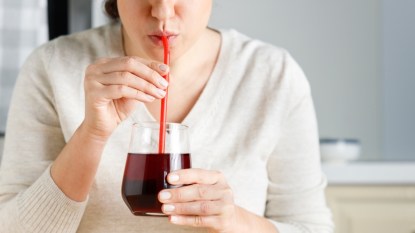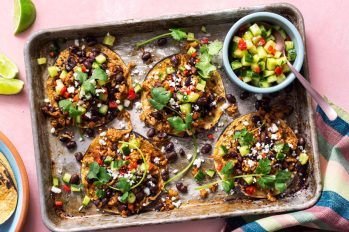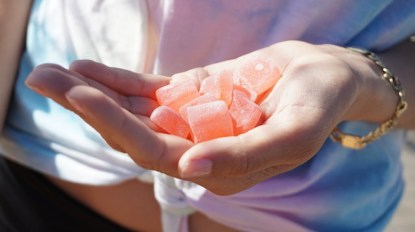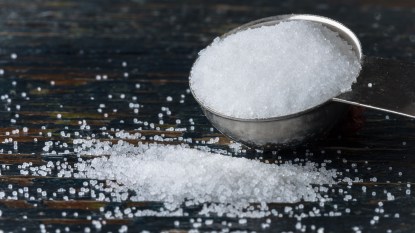Enjoying This Delicious Sweet More Often Could Help Lower Your Blood Pressure
Just in case you need another reason to indulge.

Need an excuse to eat more chocolate? Look no further than this study from Scientific Reports. In measuring the nutritional intake of more than 14,000 women in the UK over the course of 20 years, researchers discovered that a diet rich in flavanols was linked to lower blood pressure.
Flavanols are a subset of flavonoids, which are essential nutrients full of antioxidant and anti-inflammatory properties. Flavanols are commonly found in tea, red wine, and colorful fruits and vegetables. They are especially abundant in cacao beans, and thus, cocoa powder as well.
During the study scientists used nutritional biomarkers, or certain compounds found in blood or urine, to accurately determine the amount of flavanols participants were consuming. They found that a high flavanol intake was associated with a significantly lower systolic (the all-important top number) blood pressure. In fact, women who consumed the most flavanols had a systolic blood pressure that was 2.5 points lower than women who consumed the least. This improvement is similar to the long-term benefits of the Mediterranean diet.
A difference of just a few points may seem insignificant, however the researchers say even a small reduction in the average blood pressure of a population can have a big impact. It may reduce cases of hypertension and, in effect, reduce the number of people at a higher risk of cardiovascular disease.
It should be noted that for many participants in this study, the main source of flavanols was tea. As a result, the study findings may not be representative of other populations that don’t have a strong tea culture. In addition, researchers learned that there were no significant links between flavanol consumption and cardiovascular disease or death caused by cardiovascular disease.
Still, flavanols have been shown in previous studies to reduce blood pressure and improve vascular function. Cocoa powder in particular may lower blood pressure because it contains more epicatechin (a polyphenol and antioxidant) than most foods. Epicatechin improves vascular function by promoting nitric oxide, a molecule in the body that relaxes blood vessels and causes them to widen, thereby increasing circulation.
The polyphenols in chocolate also have anti-inflammatory effects. They may even positively influence insulin resistance and can, in effect, reduce a person’s risk for diabetes.
So, what does all of this mean? First, chocolate and other flavanol-rich foods definitely have a place in an anti-hypertension diet. However, the type of chocolate and the amount of chocolate you consume matter. According to the U.S. National Institutes of Health’s National Library of Medicine, the overconsumption of sugary, fatty chocolate may lead to weight gain and high blood sugar.
Investigators from the Harvard School of Public Health recommend that you get your cocoa flavanols through natural cocoa powder. It’s important that the powder is not processed through the Dutch method, which means it has been alkalized (washed in an alkaline solution to neutralize the cocoa’s acidity). Non-alkalized cocoa powder contains far more flavanols, though it is also more bitter.
If you would rather eat chocolate bars, remember that dark chocolate has more cocoa and more flavanols than milk chocolate. The amount of cocoa in dark chocolate will vary from brand to brand, so make sure you read those nutrition labels!
Whether you add cocoa powder to your smoothies or dip your berries in melted dark chocolate, scientists from Harvard Health suggest a daily intake of 200 mg of flavanols. You can reach this allotment with 100 grams of unsweetened baking chocolate (which contains 206 mg of flavanols) or two cups of decaffeinated green tea (about 180 mg of flavanols) and one medium orange (about 66 mg).
According to the U.S. Department of Agriculture’s Database of Flavonoid Content, other good sources of flavanols include:
- Fennel leaves, 84.4 mg of flavanols per 100 g.
- Fresh cilantro, 52.9 mg.
- Radicchio, 31.51 mg.
- Fresh blueberries, 17.48 mg.
- Raw collard greens, 12.95 mg.
- Raw broccoli, 11.16 mg.
- Fresh raspberries, 6.95 mg.
Note: these numbers do not include measurements of other flavonoids, such as anthocyanins, which significantly boost the overall flavonoid content of the foods listed. So, is the occasional chocolate splurge really all that bad? If you’re eating a balanced diet, the benefits of this flavanol-rich food will likely outweigh the risks.
This story originally appeared on our sister site, Woman’s World.













